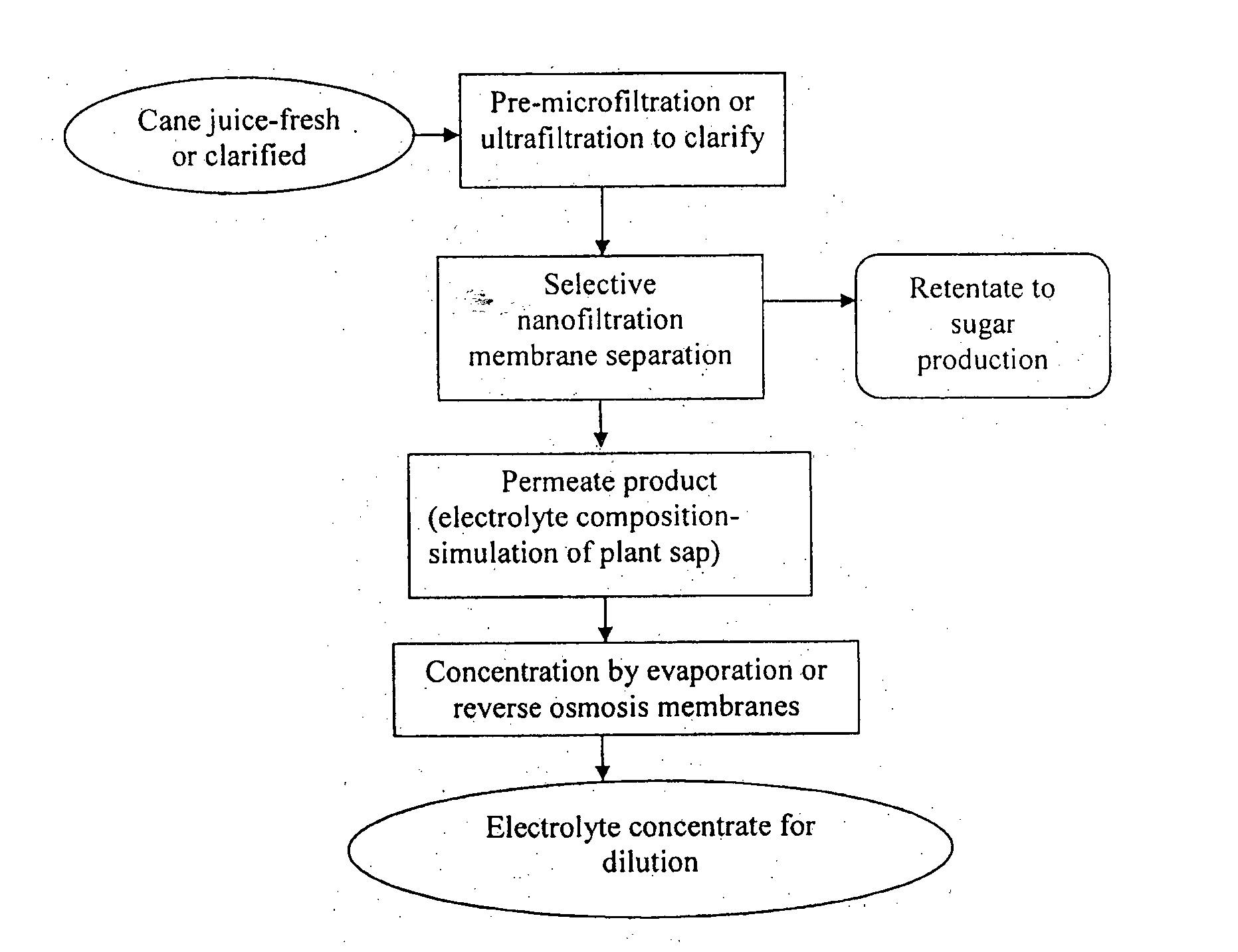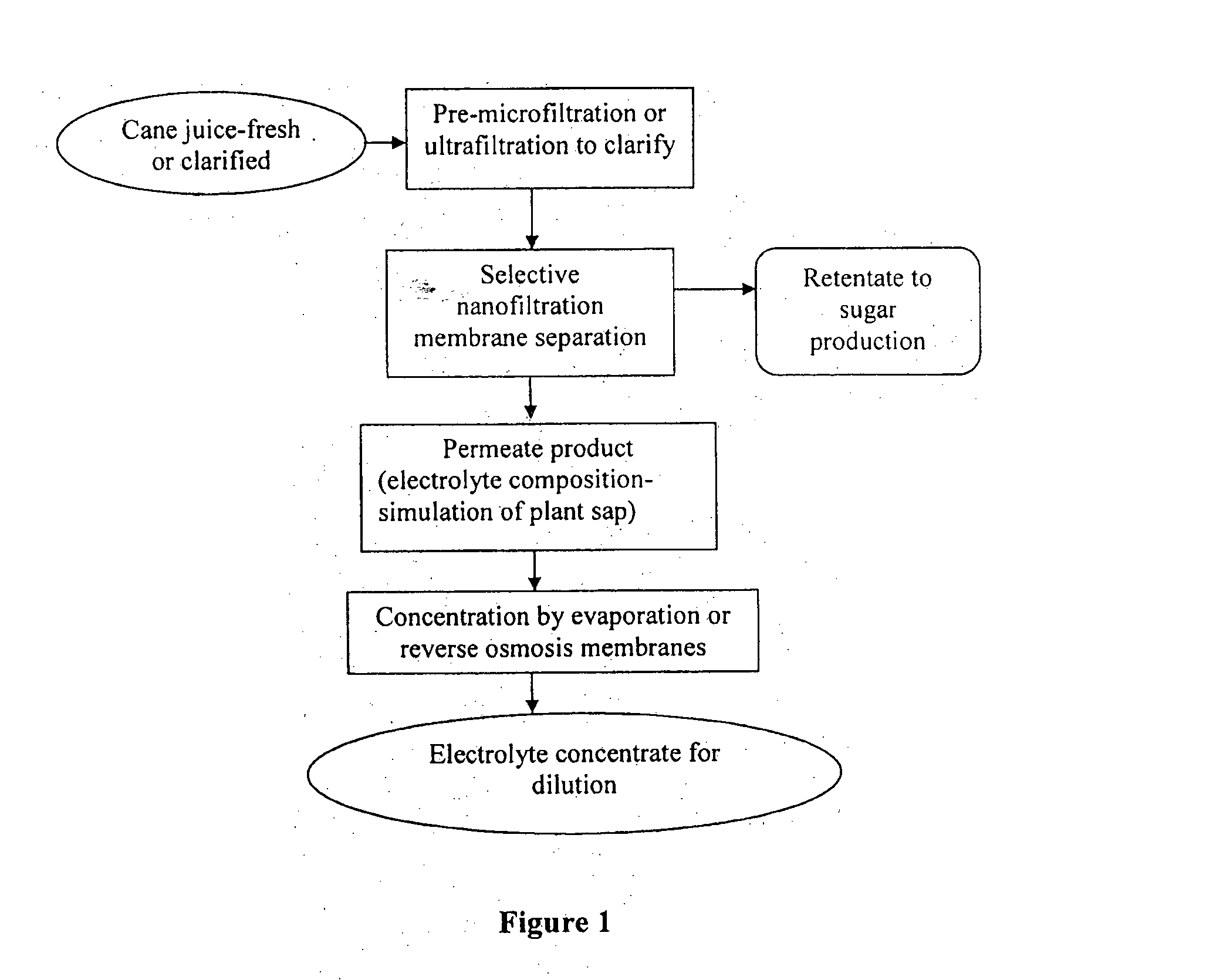Plant-based electrolyte compositions
- Summary
- Abstract
- Description
- Claims
- Application Information
AI Technical Summary
Benefits of technology
Problems solved by technology
Method used
Image
Examples
example 1
Preparation of a Sugarcane-Based Electrolyte Composition and its Concentrate
[0069]This example describes the preparation of a sugarcane-based electrolyte composition and its concentrate using sugarcane juice as starting material. A schematic of the process is shown in FIG. 1.
[0070]Table 1 below shows the typical composition of sugarcane juice based on solids (Watford S (1996) Composition of cane juice. Proceedings of the South African Sugar Technologists' Association 70, 265-266.)
TABLE 1FractionComponentContent (% w / w)SugarsSucrose81-87Reducing sugars3-6Oligosaccharides0.06-0.6 Polysaccharides0.2-0.8(including gums and dextrans)SaltsInorganic salts:1.5-3.7Potassium (K2O)0.77-1.31Sodium (Na2O)0.01-0.04Magnesium (MgO)0.10-0.39Organic non-sugarsOrganic acids0.7-1.3Amino acids0.5-2.5Dextrans0.1-0.6Starch0.11-0.5 Gums0.02-0.05Waxes, fats, phospholipids0.05-0.15Colourants0.1InsolublesSand, bagasse, etc.0.15-1.0
[0071]Pre-filtered sugarcane juice from a mill (essentially as described in ta...
example 2
Preparation of a Sugarcane-Based Electrolyte Concentrate
[0078]This example describes the preparation of a sugarcane-based electrolyte concentrate using clarified sugarcane juice as starting material.
[0079]Sugarcane electrolyte concentrate was produced from clarified sugarcane juice filtered through 100 micron stainless steel strainer from a sugar mill. The clarified juice of about 10.9% w / w total sugars was used in a two-step membrane process to produce sugarcane electrolyte concentrate (sugarcane plant sap concentrate).
[0080]A first step of the filtration was conducted using a nanofiltration (NF) membrane at an operating pressure of 35 bar and 40° C. temperature. About 375 kg of the juice was taken into a jacketed stainless steel tank and heated up to 40° C. The juice from the tank was pumped into a high pressure membrane filtration unit feed tank which is of about 20 kg capacity. The feed was frequently topped-up with fresh juice as the filtration continued while a portion of the ...
example 3
Preparation of an Apple Juice-Based Electrolyte Concentrate
[0084]This example describes the preparation of an apple juice-based electrolyte concentrate using apple juice concentrate as starting material.
[0085]A commercial apple juice concentrate of about 70 Brix was diluted with seven times RO water to obtain a single strength apple juice. This single strength juice with about 7.9% total sugars by weight was used as feed for apple electrolyte production.
[0086]A two-step membrane filtration process similar to the one described in Example 2 was used to produce apple electrolyte concentrate.
[0087]In step 1 apple juice feed was heated to 40° C. and filtered using a nanofiltration membrane. The NF permeate, unlike sugarcane juice permeate, was found to have around 4% total sugars. This is because the sugars present in the apple juice are mainly monosaccharides such as fructose and glucose (instead of sucrose as in sugarcane juice) and easily permeate through the NF membrane. In this case...
PUM
 Login to View More
Login to View More Abstract
Description
Claims
Application Information
 Login to View More
Login to View More - R&D
- Intellectual Property
- Life Sciences
- Materials
- Tech Scout
- Unparalleled Data Quality
- Higher Quality Content
- 60% Fewer Hallucinations
Browse by: Latest US Patents, China's latest patents, Technical Efficacy Thesaurus, Application Domain, Technology Topic, Popular Technical Reports.
© 2025 PatSnap. All rights reserved.Legal|Privacy policy|Modern Slavery Act Transparency Statement|Sitemap|About US| Contact US: help@patsnap.com


